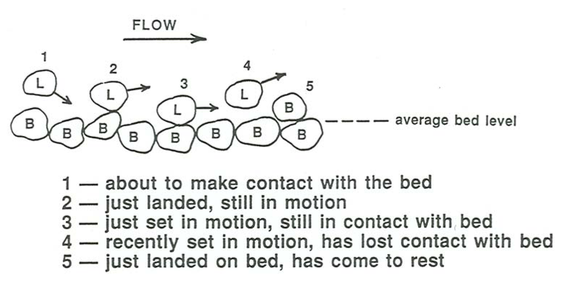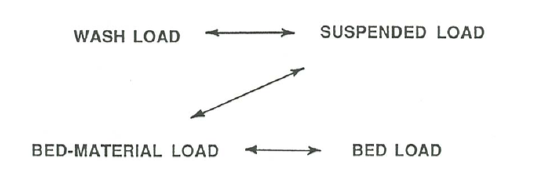10.2: The Bed, the Flow, and the Load
- Page ID
- 4212
The aggregate of sediment particles being transported by a flow at a given time is called the load. At the very outset, it seems appropriate to define what is meant by the bed, the flow, and the bed load (Figure \(\PageIndex{1}\)). (I am not sure that the following definitions, intuitive as they seem to me, would be approved by all specialists in sediment transport.) The bed comprises all of the particles that at a given time are motionless and in direct contact with the substrate, and the load comprises all of the particles that are in motion in a given flow, whether or not they are in contact with the bed. That leaves the less certain definition of the flow: all the material, fluid and solid, that at a given time are in motion above the bed.

The load can further be subdivided in two different ways. On the one hand, the load can be divided into bed-material load, which is that part of the load whose sizes are represented in the bed, and wash load, which is that part of the load whose sizes are not present in the bed in appreciable percentages. The wash load, which if present is always the finest fraction of the load, is carried through a reach of the flow without any exchange of sediment between the bed and the flow. On the other hand, the load can also be divided into bed load, which travels in direct contact with the bed or so close to the bed as not to be substantially affected by the fluid turbulence, and suspended load, which is maintained in temporary suspension above the bed by the action of upward-moving turbulent eddies. I hope that it is clear from these definitions that bed load is always bed-material load, and suspended load is likely to be partly bed-material load and partly wash load, although in particular cases it could be all wash load, or all bed-material load. Confused? Figure \(\PageIndex{2}\) may or may not be of help.

The movement of bed load is sometimes called traction. Bed-load movement can be by rolling, sliding, or hopping. Words like those three are not entirely adequate for the task of describing the nature of bed-load movement, however, because the moving particles commonly partake of all three “modes”, which vary in importance from movement event to movement event, and from instant to instant during a movement event. It is not easy to observe bed-load movement in great detail, but when you have the chance to watch a carefully made high-speed close-up motion picture of bed load (in flows where the load is not yet so abundant as to obscure one’s view) you see that the particles characteristically take occasional excursions downstream, by rolling and hopping along irregularly, and then come to rest for some time before being moved again.
Particle shape has a substantial influence on mode of bed-load movement: disk-shaped particles have a much greater tendency to slide or bulldoze, whereas equant or spheroidal particles have a much greater tendency to roll or hop. Discoidal particles can under some conditions be seen to roll like cartwheels!
There is clearly a problem in distinguishing between bed load and suspended load: how far can a particle move up into the flow and still be considered bed load? The standard criterion is whether or not fluid turbulence has a substantial effect on the time and distance involved in the excursion. It is important to keep in mind that there is no sharp break between bed load and suspended load: a given particle can be part of the bed load at one moment and part of the suspended load at another moment, and not moving at all at still another moment. The consequence of this is that at any given time there is an appreciable overlap in the size distributions of the bed load and the suspended load, although obviously the suspended load tends to be finer than the bed load. Moreover, there seems to be no sharp break, or jump discontinuity, in the volume concentration of sediment upward from the bed-load layer into the suspended-load layer (although accurate observations are not easy to make). That is to be expected, because in a sense the bed-load layer acts as the “lower boundary condition” for the suspended-load concentration; see the later section on suspension.
The relative proportions of the bed material that moves as bed load and as suspended load depend upon the characteristics of the bed material, especially its size, and on the flow conditions. Very coarse bed material in rivers (gravel) generally moves as bed load, whereas fine to medium sands move predominantly as suspended load. The mode of movement of the coarser sand sizes generally varies depending on the hydraulic conditions: at low flow intensities the coarser sand fractions move predominantly as bed load, whereas at high flow intensities they are taken into suspension. Even at the same average discharge, sand of a given size may alternate between suspension and traction, as it is caught up by powerful eddies (for example, the separation eddies formed on the lee sides of major bed forms) or returns to the bed in less turbulent parts of the flow. Most sand sizes do not travel in continuous suspension; the very fact that these sizes constitute a major part of the bed material in most rivers indicates that they are taken into suspension only intermittently. To distinguish this mode of transport from the almost continuous suspension typical of wash load, which is generally composed of particles finer than fine sand, we could call the coarser part of the suspended load the intermittent suspension load.
The distinction between bed load and suspended load can be made either on a practical observational basis or on a more theoretical basis with reference to support mechanisms. The practical definitions, those given above, are based on the observation that the bed load is carried in direct contact with the bed or very close to the bed whereas the suspended load is carried far above the bed. The more theoretical definitions are based on the concept (not easily applied, in practice!) that the suspended load is the part of the load that is supported entirely by fluid turbulence, and the bed load is the part of the load that is supported in one way or another by the bed itself, not by fluid turbulence. Bed-load particles that are moving in direct contact with the bed are supported, at least in part, directly by the bed, if the possible contribution of fluid lift forces is left out of account. By this definition, bed-load particles that are temporarily not in direct contact with the bed are either following a path that is largely unaffected by fluid turbulence, in consequence of having parted contact with the bed by a momentarily stronger fluid force (saltating particles fall naturally into this category) or are maintained in motion above the bed, perhaps at a distance of many particle diameters, by collisions with other particles that are part of a thick bed-load layer at high flow intensities. There will be more to say about the existence and nature of these latter bed-load layers later in this chapter.
Finally, here are a few words about how sediment concentration might be measured. Measuring the concentration of suspended sediment is fairly straightforward: you could imagine capturing a volume of the flow, in a snap- close bottle of some kind that does not disrupt the flow very much, and measuring the volume or mass of sediment per unit volume of the fluid–solid mixture. Provided that the measured volume is small relative to the characteristic spatial rate of change of “average” concentration (for example, you would not want your sample to integrate over a large fraction of the flow depth) but large enough relative to small-scale variations in sediment concentration related to the details of local eddy structure, your sample should provide a representative measure of the local average sediment concentration. Measuring the concentration of bed load, however, is a different matter. The bed-load layer is by its very nature thin. People attempt to measure the transport rate of the bed load (that is not a trivial matter either; see the later chapter on transport rates) but ordinarily not the bed- load concentration. Conceptually, however, it is reasonable to think about a kind of “area concentration” of bed load: the volume or mass of bed load, per unit bed area and as a time average, above a small area of the sediment bed. But I cannot provide any helpful ideas about how to measure such a quantity.


